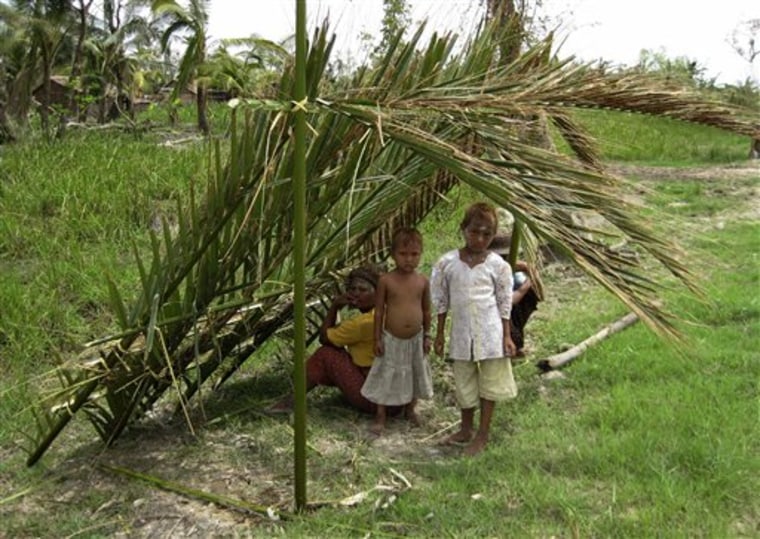Myint Hlaing's family bathes and cooks with water from an irrigation ditch fouled by human waste and a rotting cow carcass.
His 10-year-old daughter drinks bottled water donated by aid groups, but she still suffers from diarrhea. Meanwhile, his family and other cyclone survivors endure daily rains in tattered thatch huts as the monsoon season nears.
Myanmar's junta insists health conditions are normal in Myanmar's devastated Irawaddy delta. But in many areas of the delta, they are a recipe for disease.
"Shelter is the most important thing we need," Myint Hlaing said Monday. "There are more and more mosquitoes here. We are afraid of getting dengue fever."
Relief group Church World Service has reported finding elderly and child survivors of the cyclone dying from dysentery in some areas because many have no choice but to drink dirty water. Other groups have detected a number of ailments including pneumonia, malaria, cholera and diarrhea.
Many challenges ahead, including rain
Save the Children UK has warned that some 30,000 children in the delta were severely malnourished before Cyclone Nargis struck, with thousands facing starvation in the next two or three weeks. The monsoon season, which begins next month, adds yet another challenge.
"The rain is a real problem," Eric Stover, lead author of a critical report published last year about Myanmar's broken health system, told The Associated Press after visiting the delta. "The water is rising up, and the latrines are just outside (flowing) into the water, and there's livestock around. That's the perfect breeding ground for diarrhea and cholera."
Stover, a professor of law and public health at the School of Public Health at the University of California, Berkeley, managed to slip past military checkpoints twice to get a glimpse of the devastation. He was unable to assess the health situation in villages, but said conditions are ripe for outbreaks.
"It's as bad as we all think it is, there's no question about that," he said. "I think for public health people and for U.N. personnel the frustrating thing is that they can't see it."
UNICEF has been canvassing the area and has reported a growing number of diarrhea cases — up to 30 percent of young children in one township. Myanmar's Ministry of Health has started vaccinating some children in camps against measles, another big threat.
The World Health Organization says it still doesn't have a clear medical picture because tight government restrictions have kept the delta off-limits to its foreign experts. Remote villages accessed only by boat remain the biggest question mark because many still have not been reached more than three weeks after the storm.
"We have no hard numbers," said Maureen Birmingham, a WHO epidemiologist in Thailand. "We continue to remain concerned because it's a high-risk situation for diarrheal disease, malaria and dengue."
Aid still being kept away
Myanmar's xenophobic government has worked hard to keep foreign aid agencies from visiting the delta since the May 2-3 storm belted the region, killing some 78,000 people and leaving 56,000 others missing. It has not reported any disease outbreaks.
The regime has said it is able to handle relief efforts on its own, but its ruling general assured visiting U.N. Secretary-General Ban Ki-moon last week that all international aid agencies would be allowed in to help. It remained unclear Monday how many foreigners would be permitted to travel beyond Yangon, the country's largest city.
Access to regular supplies of safe drinking water and proper sanitation is essential for preventing waterborne diseases like cholera, which spreads rapidly through water contaminated with feces. Malaria and dengue fever outbreaks also will be a major concern in the coming weeks after mosquitoes have time to breed in the stagnant water that flooded the delta.
Myanmar was plagued by malaria, tuberculosis, AIDS and other big killers before the disaster, in a country where one in three children is estimated to be malnourished. About 3 percent of the annual budget is spent on health, compared to 40 percent on the military, according to Stover's report.
In 2000, the WHO ranked Myanmar's health system as the world's second-worst, ahead only of war-ravaged Sierra Leone.
